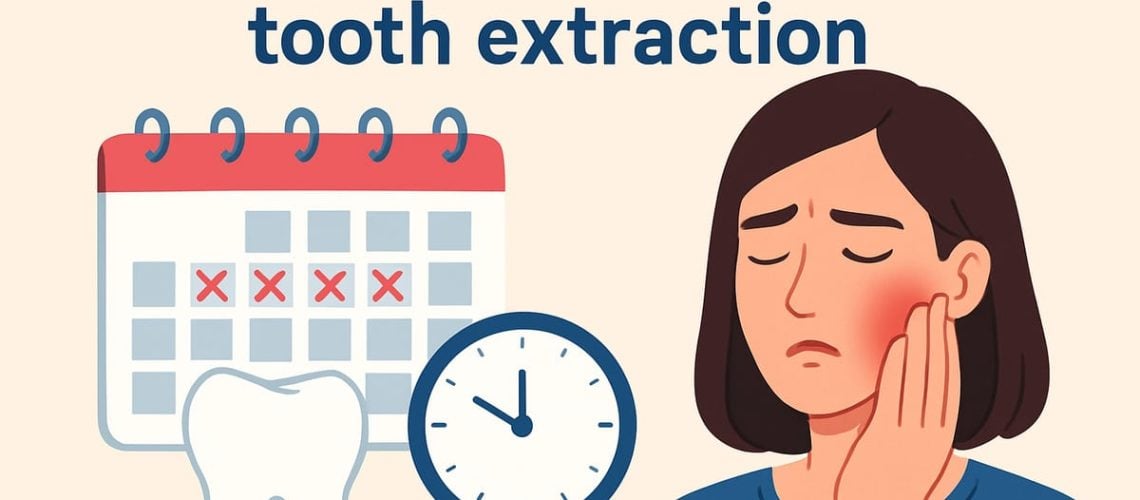If you’re wondering how long recovery from tooth extraction typically takes after wisdom tooth removal, this guide will walk you through what to expect day-by-day and week-by-week. You’ll get a clear timeline, the factors that change healing time, common symptoms and red flags, practical aftercare tips, and when extra treatments can extend recovery.
Average Recovery Timeline After Wisdom Tooth Extraction
- First 24 hours: Expect bleeding that slows with gauze pressure, peak swelling, and the worst pain. Rest, ice, and prescribed or OTC pain meds help control symptoms.
- 48–72 hours: Swelling usually peaks then begins to subside. Pain should steadily improve. Keep soft foods and limit activity.
- 1 week: Most soft-tissue healing is well underway. Many people can return to normal eating and routine, though some discomfort may remain.
- 2 weeks: Stitches are often gone or dissolved. Major recovery is mostly complete for routine extractions.
- 3–6 months: Deeper bone remodeling and full jaw healing continue, especially if bone grafting was placed during surgery.
What Affects How Long Recovery From Tooth Extraction Takes
Patient factors
- Age — younger patients often heal faster.
- General health — conditions like diabetes slow healing.
- Smoking — delays recovery and raises complication risk.
- Medications and immune status — some drugs or weak immunity can extend healing time.
Surgical factors
Impact and complexity matter. An erupted tooth heals faster than an impacted tooth that required bone removal or sectioning. Removing multiple wisdom teeth at once increases swelling and recovery time.
Anesthesia and adjuncts
IV sedation and effective local anesthesia make the procedure more comfortable but don’t change the biological healing time. Biologics like platelet-rich fibrin (PRF) can speed soft-tissue healing and reduce discomfort for some patients.
Post-op care and complications
Poor aftercare, dry socket, or infection will lengthen recovery. Following instructions for oral hygiene, diet, and activity is one of the biggest factors you control.
Common Symptoms During Recovery and When They Should Improve
- Pain: Worst during the first 24–72 hours, then a steady decline. Call if pain worsens after 72 hours or is getting steadily worse.
- Swelling: Peaks around 48–72 hours and then decreases. Increasing swelling or spreading redness needs evaluation.
- Bleeding: Light oozing is normal for the first day. Heavy bleeding or soaking through gauze is a reason to contact your surgeon.
- Numbness/tingling: Mild numbness from nerve irritation can occur. Persistent numbness longer than a few days or new, worsening nerve symptoms require urgent follow-up.
- Fever/infection signs: Low-grade fever can happen, but high fever, worsening pain, pus, or bad taste should prompt a call for possible antibiotics or drainage.
Practical Steps to Speed Healing and Reduce Pain
- Immediate care: Use gauze pressure for bleeding, ice packs on the cheek for the first 48 hours (20 minutes on, 20 minutes off), and keep your head elevated while resting.
- Pain control: Follow your surgeon’s instructions. Use acetaminophen or NSAIDs if recommended; take prescription opioids only if needed and exactly as directed.
- Oral hygiene: Avoid rinsing vigorously for 24 hours. After 24 hours, gently rinse with warm salt water several times a day. No straws, spitting, or smoking for at least 72 hours.
- Diet and activity: Start with soft foods (yogurt, mashed potatoes, smoothies without a straw). Most people return to work or school in 2–4 days for routine extractions; avoid heavy exercise for a week.
- Smoking and alcohol: Both impair healing. Do not smoke or drink alcohol for at least 72 hours; longer abstinence is safer, especially after complex surgery.
When Recovery Takes Longer — Additional Treatments and What They Add to Healing Time
Complications and extra procedures can extend recovery:
- Dry socket: Often appears 2–5 days after extraction with severe pain. Treatment (medicated dressings and pain control) adds several days to weeks of discomfort.
- Infection: May require antibiotics and sometimes drainage; expect extra days to weeks for full resolution.
- Bone grafting or sinus work: Adds months for bone to mature, though soft-tissue comfort often improves within 1–2 weeks.
- Nerve involvement: If a nerve is affected, monitoring and possible specialist referral are needed. Recovery can take weeks to months, and permanent changes are uncommon but possible.
Choosing Care That Helps Reduce Recovery Time
Thoughtful surgical planning and experienced surgeons can shorten recovery and lower complications. If you’re asking how long recovery from tooth extraction Dallas–Fort Worth will be, choose a team that offers board-certified surgeons, on-site IV sedation, and advanced planning tools.
At Texas Center for Oral Surgery & Dental Implants, our board-certified oral and maxillofacial surgeons use CBCT planning, PRF to boost healing, and minimally invasive techniques to support predictable recoveries. If you want a personalized timeline and a clear aftercare plan, schedule a consultation to discuss your case and expectations.

